How to Play Trundle Lissandra Ledros Control
Sometimes with the way the world is right now, we could all use a little extra Tender Loving Care.
And what better way to do that than to obliterate an opponent’s deck or throw giant men at their head?
Welcome, everybody, I’m Jordan “WhatAmI” Abronson and today we’re paying tribute to the new ice queen of the metagame, Miss Lissandra, and her trolly pals.
TLLC Decklist
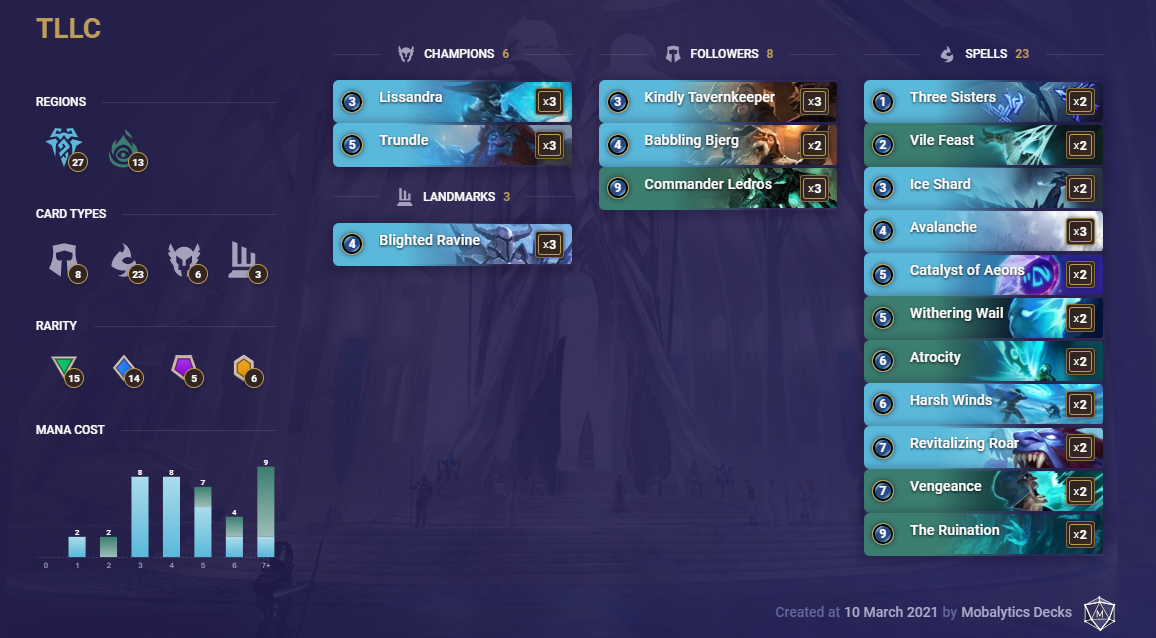
Deck Code: CECAEAIBCQZAEBABAUHACAYBAYAQCBJBAQBAIAIJBICQCBIBB4MR2KADAEAQODBKAEBQCBAA
Variations on this deck have been floating around tier two ever since Revitalizing Roar was released.
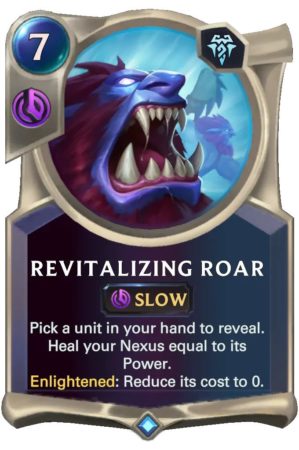
The juicy combo of being able to twenty, or at least nineteen, to zero your opponent in one turn with roar, Ledros, and Atrocity, was too much to not at least take a look at.
The new tools that Shurima has brought though may finally be enough to kick this terrifying control deck with its combo finish into the top tier.
Where before you only really had one avenue of winning, maybe one and a half if you count Trundle, now Lissandra gives you an entirely separate victory condition.
Her level up is very easily achievable with a single Trundle Pillar and a Ledros, and then your opponent has to not only be on the watch for an atrocity headed their way, but also a Roar bringing down a zero-mana Watcher for some deck-obliterating good times.
Not to mention that simply dropping her on turn three puts a serious clock on the game as a zero mana 8|8 Overwhelm is no joke.
To top off the Shuriman goodness, Ice Shard, and Blighted Ravine incidentally damaging your opponent means that you rarely have to worry anymore about your big combo being only nineteen damage as opposed to twenty.
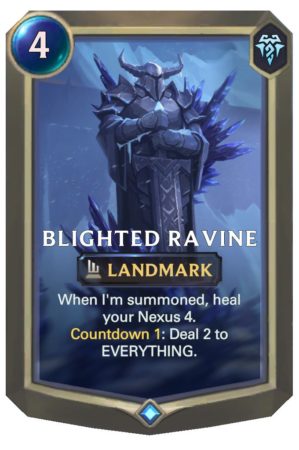
All these powerful new additions make this deck a swarm-crushing tool and a serious end-game threat.
Let’s dive into the nitty-gritty of how to play it out.
Phase One: The Pass Button is Your Friend
While this is true of nearly every control deck ever made, I think it is more true here possibly than it has ever been before.
The cards in your deck are all set up to create forks in your opponent’s gameplay, and often the best way to take advantage of that indecision is to pass.
Do they open attack and lose to Ice Shard, Withering Wail, Vengeance, and Freeze effects?
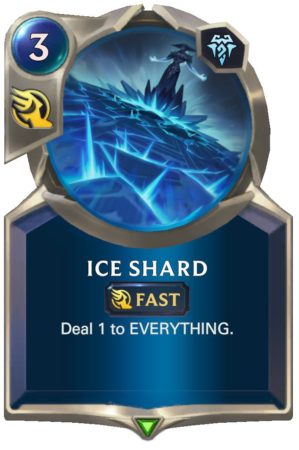
Do they develop and get hit by an Avalanche or Ruination?
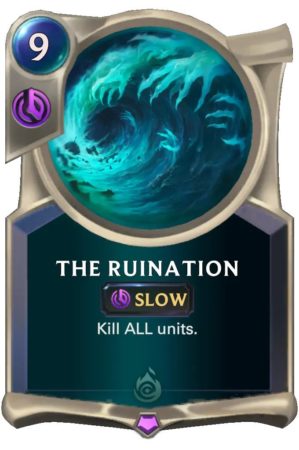
Is their attack small enough we can simply shrug and heal it up with Catalyst, Blighted Ravine, Kindly Tavernkeeper, or Revitalizing Roar?
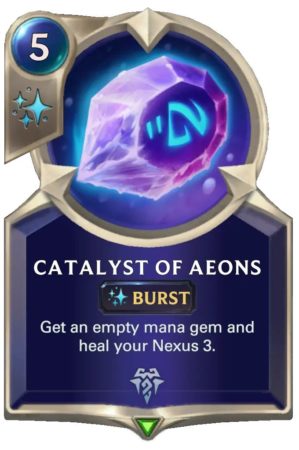
They always have to ask those questions and it’s our job to make them.
If we use our mana too early then our opponent suddenly has a much narrower range of options to consider and their plays get easier.
Even if they simply pass back to us and take some of our mana, that’s usually just fine.
We’re a deck that wants to get to turn nine-plus pretty much every game.
Every turn that passes forward, any attack token that our opponent doesn’t use, that’s percentage points accruing in our favor.
Phase Two: Pull the Trigger
At some point, we really do have to actually answer all the threats our opponents are going to be dropping to come for our Nexus health.
Whenever you’re considering the board state and how you want to develop try to look ahead and decide how you’re going to deal with each threat being presented.
Sometimes it’s as simple as Avalanche plus Withering Wail to deal with a board of two to three toughness creatures.
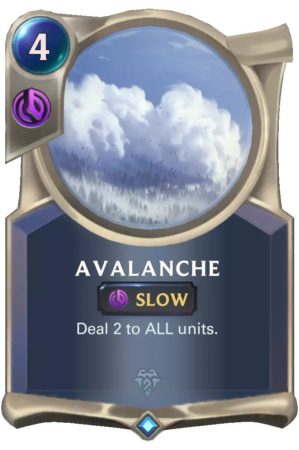
Other scarier things may need you to stall out a few turns so you can get a Ruination down to deal with them.
Is our opponent likely to be a Ruin Runner deck?
Maybe we should see if we can hold on to that turn two Vile Feast to pop a Spell Shield going into our big Ruination turn on six or seven.
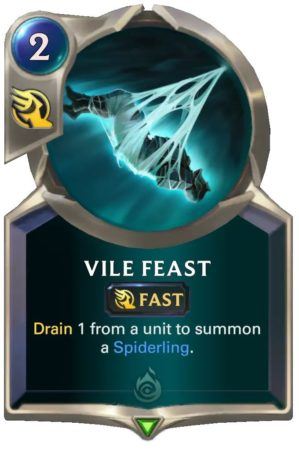
Don’t underestimate Lissandra, Bjerg, and Tavernkeeper when it comes to this phase of the game.
Having some mid-sized bodies on blocking duty is a very good way to soften up bigger threats for our area of effect spells to take down.
While getting a Lissandra win is definitely cool, don’t be afraid to block with her.
Part of her job is to be a solid wall in the mid-game, and while she does good work, most of our wins in this deck are still going to come from Ledros.
Phase Three: Remember Your Win Conditions
While the big one-turn combo of Roar plus Ledros plus Atrocity is exciting, this is a deck that has a bevy of less prevalent but totally viable alternate win conditions that are not to be underestimated.
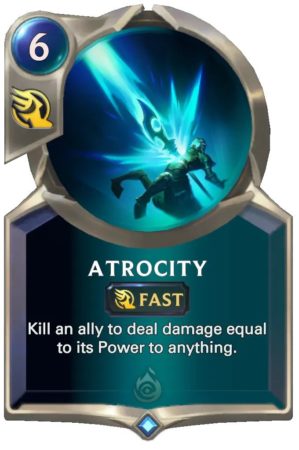
One of the key skills to playing a deck like this is knowing where and when to choose what path to victory.
Our two champions will occasionally be our game closers.
Trundle has shown his chops for many a season now, and against an aggressive or midrange opponent, one or two swings from the big club, possibly backed up by an Atrocity is often enough to seal a game.
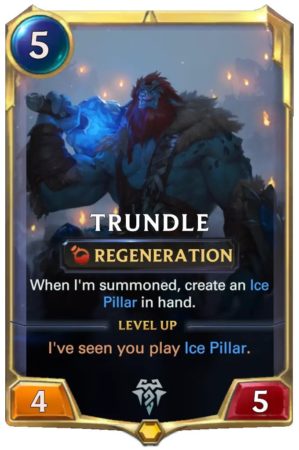
Lissandra’s level up is amazingly hard for burn decks to deal with, and will shut the door hard on any swarm strategy.

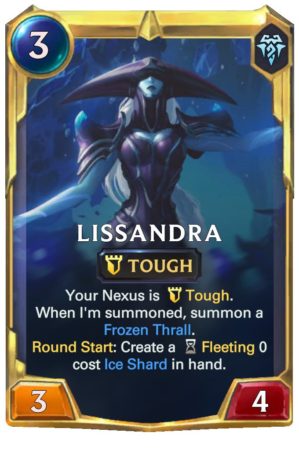
If you have a Revitalizing Roar to back her up then The Watcher will fully heal you and happily one-shot your opponent.
Sometimes the 8|8 that Lissandra drops will even be enough to close a game, or assist in your opponent’s demise.
Last, and probably least but still important to keep in mind, Ledros has Fearsome.

There are a surprising amount of games where you can either use a Trundle Pillar to pull aside your opponent’s only blockers, or simply freeze them out of the way and deliver a nine-point bonk with Ledros.
As you are stalling out your games and dropping the answers to the terrible threats your opponents will be sending your way, always be on the lookout for your opportunity to turn the corner.
Sometimes it’s as simple as taking a big hit to drop a Ledros on turn nine, and then having Atrocity mana on turn ten.
I think possibly the most important skill in Runeterra is looking for your victory conditions, and this is a great deck to train that skill.
Key Choices
Our metagame is still very much in flux here, and there are a bunch of different ways to build this deck.
So I thought I’d talk about them here at the end instead of trying to go into specific matchups that might be outdated by the time I finish writing the article.
Where are all the Thralls?
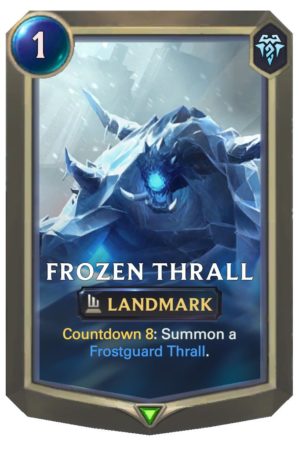
Lissandra came with a lot more Thrall support, didn’t she?
The base card Frozen Thrall and Draklorn Inquisitor are sitting on the sidelines feeling extremely left out during this deck review. Why didn’t they get featured?
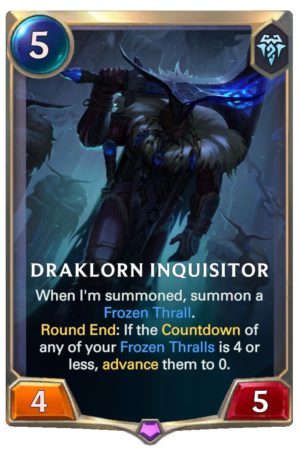
The honest answer is that it’s a tech choice. If you want to find space for the Thralls to shine you totally can, but you end up sacrificing some of your consistency against more aggressive opponents.
If you’re comfortable with shifting your matchup tables in that direction though then 8|8 Overwhelms can get a lot of jobs done very quickly
I would recommend Draklorn Inquisitor over Frozen Thrall as your first slot if you are looking to bring in that package.
Draklorn does some pretty good work on its own as a beefy body, but drawing Frozen Thrall past turn one is pretty sad.
Spectral Matron/Fading Memories
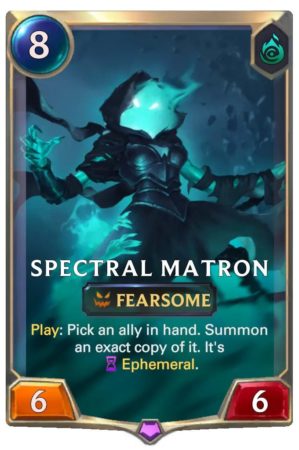

Looking to include those cards is an even larger commitment and will skew you less into the control side of things and more towards the combo.
At that point, you are looking to seriously attempt to end the game on turn eight or nine as opposed to attempting to be the inevitable checkmate deck.
That build will make you significantly better against other control decks, but you will once more end up losing some serious percentage points against aggro.
You also lose some level of consistency because many of your cards cease to function on their own without certain specific synergy points.
If you are going to look at running that version of the deck I would strongly suggest including Entreat in your forty cards as you basically need both of your champions to win any given game.
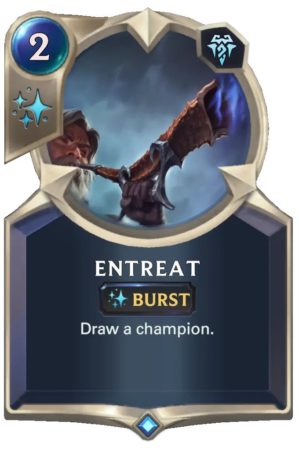
Also, look to protect or potentially not even develop an unleveled Lissandra.
She can’t block nearly as blithely when she is a necessary part of your endgame.
Conclusion
This deck definitely has a very particular playstyle.
It’s glacially, freezingly slow, right up until it turns the corner and ends the game in one or two turns.
I wouldn’t recommend this deck unless you enjoy that kind of play, but if you do it can be immensely rewarding.
I think this is also a deck that has a lot to teach about the depth of Runeterra in general.
Playing this deck and mastering the nuances of its passes and victory conditions will give good guidance on how to think about the game for many other decks.
Best of luck to y’all out there on ladder.
May your Ledros and Bjergs always show up in the top twenty cards of your deck.
Thanks for reading! If you have any questions, feel free to ask WhatAmI during his streams (around 10AM PST basically every day).
WhatAmI streams at twitch.tv/xxwhatamixx around 10AM PST every day
Subscribe to our newsletter:
Don’t miss out on all of the latest LoR content!
 Download APP
Download APP